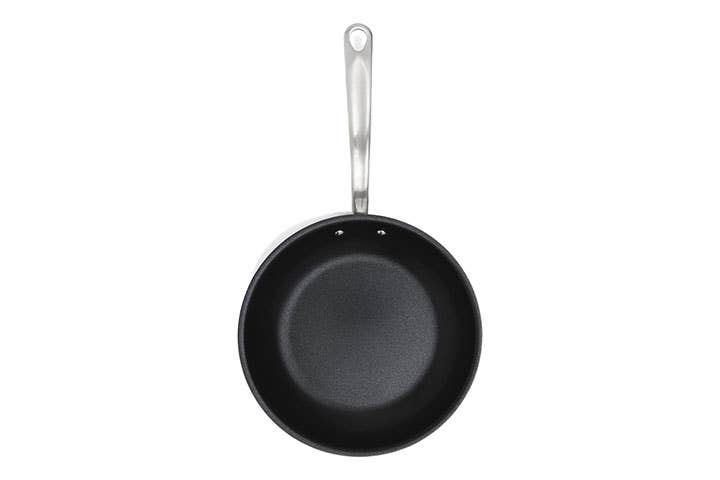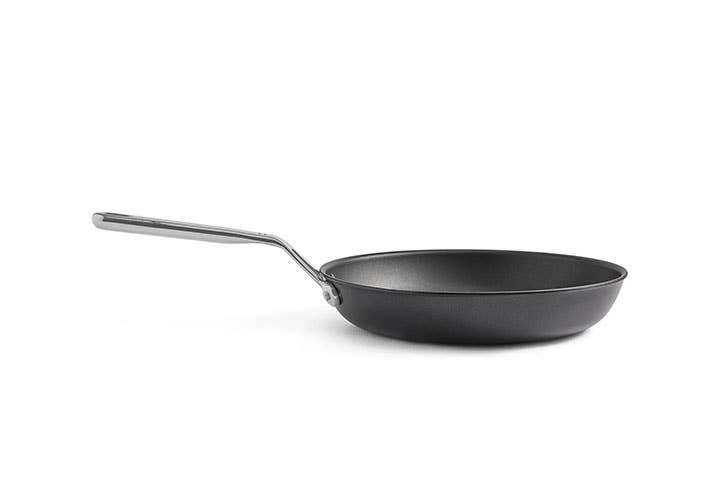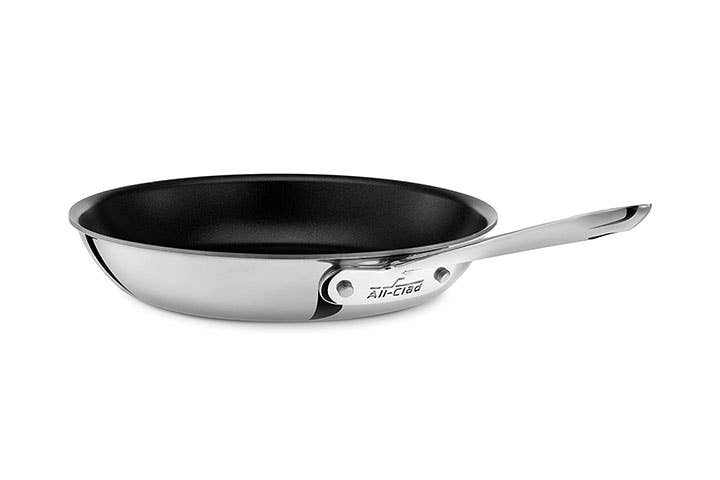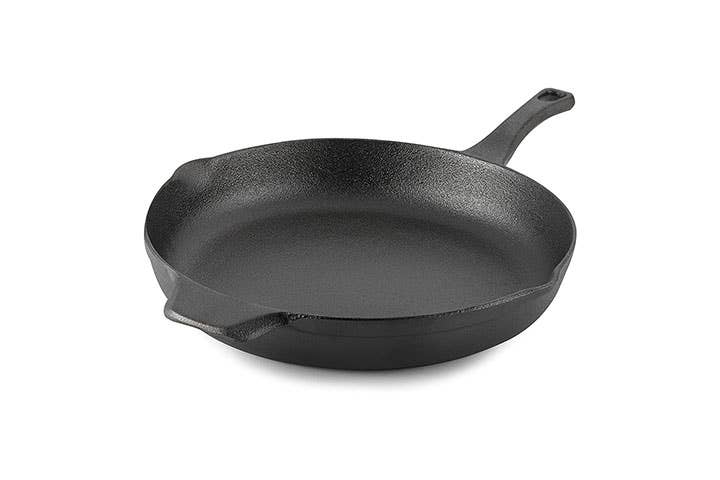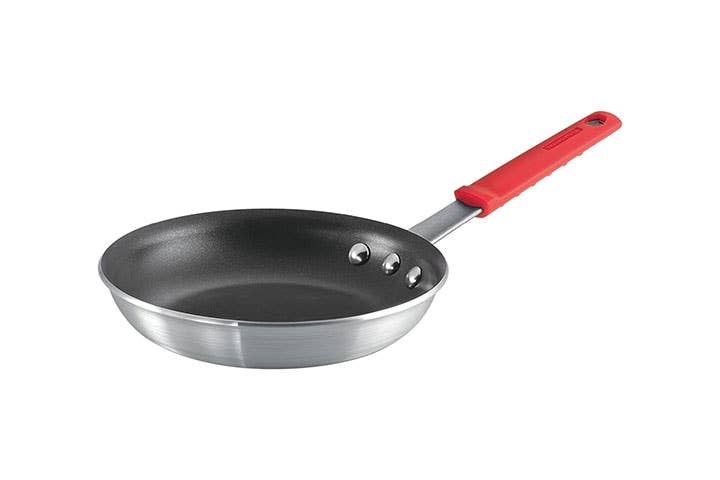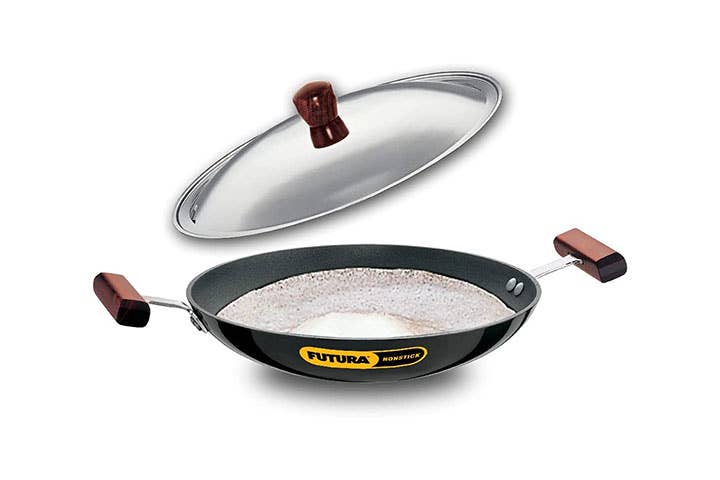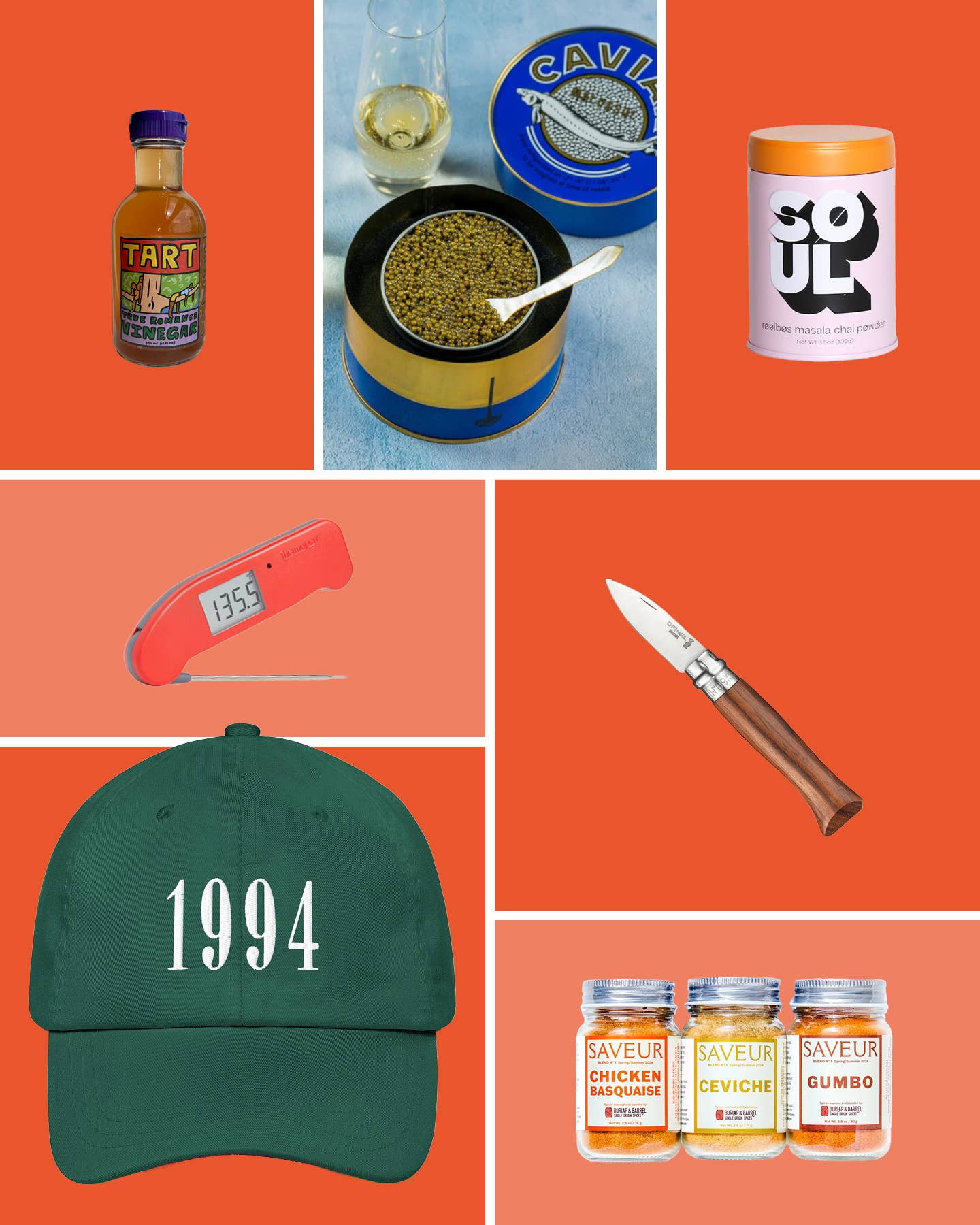The Best Pans for Eggs Keep Breakfast Mess-Free
With nonstick surfaces and curved sides, these pans can help you step up your egg game.
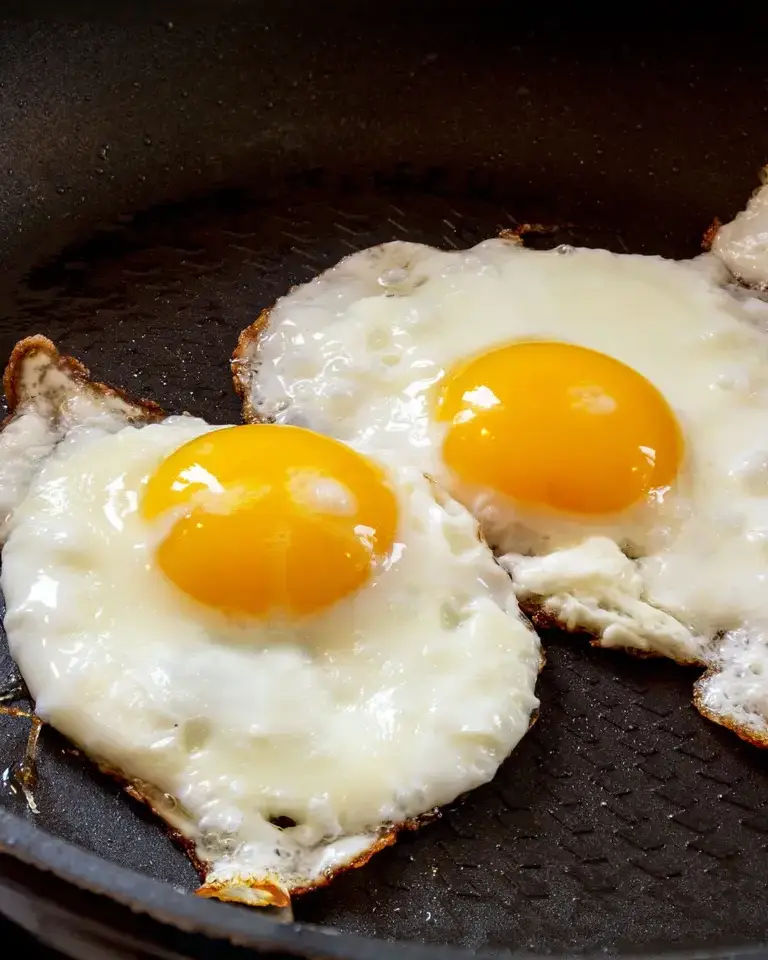
When it comes to pans for eggs, chefs know best. They’ve often been through many to find the one that stands above the rest. But each chef’s egg pan of choice is different. Some love classic All-Clad, others prefer Made In’s nonstick pans, while a few prefer a vintage cast-iron skillet or a thrifted egg hopper pan. Ultimately, whichever you choose should be the pan that will work best in your kitchen.
So which pans are truly the best? Is All-Clad worth the investment? And which nonstick pans actually hold up? As Charles Gardiner, executive chef of The Ballantyne Hotel says, “with practice, a cook can use any pan with the right amount of heat and oil.” But, of course, having a quality pan to start with can only help. We spoke to chefs from across the country to get their insights and recommendations on the best pans for eggs.
Our Top Picks
- Best Overall: Made In Nonstick Frying Pan
- Best Value: Misen Nonstick Pan
- Best Restaurant-Quality Pan: All-Clad Nonstick Fry Pan
- Best Cast Iron: Calphalon Pre-Seasoned Cast-Iron Skillet
- Best Nonstick: Tramontina Professional Fry Pan
- Best Underrated: Futura Nonstick Appachatty Breakfast Pan
Best Overall: Made In Nonstick Frying Pan
Best Overall
Material: stainless clad | Size: available in 8-, 10-, and 12-inch options | Nonstick: yes | Induction Compatible: yes
Pros
- Durable
- Versatile
- Lightweight
Cons
- Expensive
- Handwash only
Why we chose it: A tried-and-true nonstick pan that holds up well over time.
In our research, we found that many chefs prefer nonstick pans over stainless steel and cast-iron pans for egg cookery. Made In’s version was the top pick amongst the chefs we spoke with because of its seriously high-quality and long-lasting nonstick surface. Because Made In has incorporated multiple layers of nonstick into the pan, it is built to be extremely durable—something Rece Hogerheide, executive chef of the Daxton Hotel in Birmingham, Michigan, says makes this pan stand apart. “The nonstick pans that [Made In has] created are absolute workhorses in the kitchen,” Hogerheide says. “These pans stand up to commercial everyday use in a busy hotel restaurant, where, even after a year, the nonstick coating stays true to actually being nonstick."
In addition to having a great nonstick surface, this pan is also versatile in the kitchen because of how lightweight it is and how evenly it distributes heat. This allows the pan to not only make perfect eggs, Hogerheide says, but it also can give a great sear on meat.
The biggest issues we found are that it is a bit pricey and that it should be washed by hand to protect its nonstick surface.
Best Value: Misen Nonstick Pan
Best Value
Material: aluminum core with a ceramic exterior | Size: available in 8-, 10-, and 12-inch options | Nonstick: yes | Induction Compatible: yes
Pros
- Affordable
- Long-lasting nonstick surface
- Safe to use metal utensils on
Cons
- Shouldn’t be used at a heat level beyond medium
- Handwashing recommended
Why we chose it: A nonstick pan that can help you make perfect eggs without breaking the bank.
When it comes to pans chefs overwhelmingly seem to prefer, Made In and All-Clad top that list. And while Misen doesn’t seem to have the clout that those brands do, Misen produces pans that achieve that same level of quality without costing customers a pretty penny. “I stopped using All-Clad and discovered Misen,” said Ed Cotton, executive chef and partner at Jack & Charlie’s No.118 in New York City. “I’ve had mine for a year and it’s not showing any signs of sticking at all.” The pan has four layers of nonstick coating and a ceramic exterior, which makes it pretty easy to clean, even if it is recommended to do so by hand only. As well, Misen advises to not heat this pan up beyond the medium setting on your stovetop, which seems slightly peculiar, though not altogether a bad thing for egg cookery, as the general recommendation is to not cook eggs over high heat.
Best Restaurant-Quality Pan: All-Clad Nonstick Fry Pan
Best Restaurant-Quality Pan
Material: stainless steel with aluminum core | Size: available in 8-, 10-, 12-, and 14-inch options | Nonstick: yes | Induction Compatible: yes
Pros
- Professional-grade
- Safe for oven and induction use
Cons
- Expensive
- Nonstick surface can deteriorate fast
Why we chose it: A staple pan beloved by chefs.
All-Clad is a classic option for both chefs and home cooks. Mark Strausman, chef and owner of New York City’s Mark’s Off Madison, uses All-Clad nonstick pans for cooking eggs both in his restaurant and at home. With a flat base and curved edges, this pan allows for even heat distribution and ease for flipping eggs and transferring them from the pan to the plate. This pan is also safe for induction stovetops and oven usage, making it suitable for all types of egg cookery. However, the downsides with this pan are that it is quite costly for an egg pan and both home cooks and chefs have noted that the company’s warranty doesn’t seem to hold up. This could become an issue because, as Cotton noted, the nonstick coating on the pan has a tendency to deteriorate quicker than preferred.
Best Cast Iron: Calphalon Pre-Seasoned Cast-Iron Skillet
Best Cast Iron
Material: cast iron | Size: 12 inches | Nonstick: yes | Induction Compatible: yes
Pros
- Pre-seasoned
- Affordable
- Versatile
Cons
- Heavy
Why we chose it: A trusty cast-iron skillet with sloped edges that makes for easy egg cookery.
Chefs are divided on whether cast iron skillets really make for the best egg pans. Some empathetically say yes, while others say it’s too much of a hassle. This particular pan helps bridge that gap by coming pre-seasoned, thus reducing some of the hassle that can come with using a cast-iron skillet. As well, it has sloped sides, which makes it a great pan for frying eggs, since you don’t have to worry about a harsh edge messing up your flip. But beyond just frying eggs, this skillet is great for all sorts of egg preparations, including making omelettes, frittatas and shakshuka. The only real downside to this pan is that it is heavy, clocking in at 6.8 pounds.
Best Nonstick: Tramontina Professional Fry Pan
Best Nonstick
Material: aluminum | Size: available in 8-, 10-, 12-, and 14-inch options | Nonstick: yes | Induction Compatible: no
Pros
- Scratch resistant
- Safe to use in your dishwasher and oven
- Affordable
Cons
- Not suitable for induction stovetops
- Cooking spray usage not recommended
Why we chose it: A professional-grade nonstick frying pan that makes cleanup a breeze.
“It’s one of the best pans I’ve ever purchased,” says Danny Chavez, executive chef of Art and Soul at YOTEL Washington, D.C. What makes this pan the best, according to Chavez? Cleaning it. Made with commercial-grade aluminum and an Eclipse nonstick surface, foods are not liable to stick to it, making for exceptional egg cookery and ultra-easy cleanup. Plus, unlike many nonstick pans, this one is dishwasher-safe. That being said, this pan isn’t compatible with induction stovetops (though allegedly it can be used with an induction interface disk), and it is recommended that you don’t use nonstick cooking spray on this pan.
Best Underrated: Futura Nonstick Appachatty Breakfast Pan
Best Underrated
Material: stainless steel | Size: 8.66 inches | Nonstick: yes | Induction Compatible: no
Pros
- Good nonstick surface
- Comes with lid
- Affordable
Cons
- Not suitable for induction stovetops
Why we chose it: A stainless steel pan with a rounded bottom perfect for fried eggs, hoppers and appam.
With its rounded bottom and two wooden handles, this pan might not resemble your typical frying pan. But because it has curved edges and a durable nonstick surface, it makes for one of the best pans for eggs, even if it is a pretty underrated one. Part of why this pan has a more domed shape is because it can be used to make appam, a lacy, South Indian pancake, and hoppers, thin Sri Lankan crepes that can come with or without an egg in the center. But Lena Kwak, chef and cofounder of Starday Foods, says she loves cooking her eggs in this type of pan, which she recently picked up at a garage sale. “The pan is like a mini wok,” she says. “Since it is concave in the center, I love how eggs that I cook in the pan hold a nice rounded shape. Plus, less oil splattering all over your stove.” The cool thing about this particular pan is that it comes with a lid, which can help you produce amazing fried eggs. It’s also pretty affordable, though it should be noted that this pan doesn’t work well on induction stovetops.
How We Chose These Products
When considering what pans to include on this list, we used a pre-determined set of criteria, which included material, price point, heat distribution and how well the nonstick surface performs, to determine the best pans for each category. We also received recommendations (along with some tips and tricks listed below) from chefs about the pans they prefer for making eggs, and their recommendations and insights influenced our final product list.
Features to Keep in Mind When Shopping for Pans For Eggs
Material
Consider what will work best in your kitchen and in your mornings. Chefs largely prefer nonstick pans for their ease and their ability to turn out flawless fried eggs and omelettes, but some will choose to utilize stainless steel or cast iron. Nonstick tends to be the easiest to clean, of course, and can heat up pretty quickly, while cast iron and stainless steel might take more work to wash and can take longer to come to the temperature you want. Kwak’s advice here is to “ask yourself if you have the patience to heat up a cast iron or stainless steel pan properly. If not, grab a nonstick pan.”
Sturdiness
When deciding on an egg pan, you’ll want to pay attention to how sturdy the handle is. “The handle needs to feel right,” says Monty Koludrovic, chef and culinary director of L.A.-based Botanical Hospitality Group, “It doesn't need to feel heavy, but you want it to feel sturdy and you want to be able to give it a good grip. You don't want flimsy, hollow ones that are going to end up pulling away from their screws and water getting in the handle, and then it's just a whole catastrophe.” Keep an eye out for how well the handle is attached to the pan, and if you’re shopping in-person, be sure to pick up the pan by the handle and make sure it feels firmly attached and comfortable in your hand.
Construction
Egg pans should have rounded sides. This is important for maneuvering your eggs around the pan, whether you’re making fried eggs, omelettes, scrambled eggs, or sunny-side-up eggs. The pan should also have a good scratch-resistant surface, a handle that fits well in your hand, and it should distribute heat evenly across the surface.
Easy to Clean
Perhaps one of the most major points of concern, an egg pan should be relatively effortless to clean. You’ll want to look for pans that have multiple layers of nonstick coating, as those tend to be the easiest to wash by hand. Some are so durable, they can even be cleaned in a dishwasher, though to get the most of your pan, it’s usually advised to stick with handwashing exclusively. You’ll also want to use plastic or rubber utensils on nonstick pans, as metal utensils can damage the coating, which ultimately will make it harder to clean.
Ask the Experts
Q: What size pan is best for eggs?
There isn’t a definitive best size, but the chefs we interviewed said they prefer 8-, 10-, or 12-inch pans. Koludrovic particularly prefers a larger egg pan so he can get a better texture on his fried eggs. “I like having space because I like those crispy edges,” he says. “I like having every egg have its own coastline. I don't want continents.”
Q: How do you fry eggs in a stainless steel pan without sticking?
Make sure you’re using plenty of oil and preheating the pan properly. “[The] right timing before adding oil makes a world of difference,” says Kwak. “Drop a few drops of water into a heated pan. If the water droplets pool together then you’re ready to add oil and fry the egg.”
That being said, stainless steel doesn’t necessarily make for the best pans for eggs. Many chefs prefer nonstick pans over stainless steel. Stathis Antonakopoulos, executive chef and owner of Carnegie Diner & Cafe, is one of those chefs, as he doesn’t use stainless steel for cooking eggs at his restaurant. He advises that if you do, “use a half cup of Greek extra virgin olive oil in medium heat with a small pan cover, shake the pan constantly and use a rubber spatula.”
Q: Are cast iron pans good for eggs?
While some chefs love a cast-iron pan, the chefs we spoke to largely recommend using nonstick pans, since those tend to be better for eggs on the stovetop. That being said, they are particularly good for oven usage and delicate preparations. Koludrovic uses a cast-iron pan at home to make pan-fried quail eggs for Nicoise salad so that he can cook the quail eggs quickly yet gently. “It's a pan that takes more maintenance than a stainless steel or a Teflon-coated [pan],” he says. “[But] they hold their heat really well, which is good. They're nonstick, which is good. You get a nice crisp on them. And you don't have to season a cast-iron pan every time you use it. But depending on how often you use it, it's probably a process that you're gonna do three or four times a year on a good pan.”
Q: Why do my eggs always stick?
A few reasons, according to Kwak: 1) Your eggs might not be fresh; 2) the pan might not be hot enough; 3) the pan might be scratched; and 4) you might not have used enough oil.
Our Take
Nonstick reigns supreme. While cast iron and stainless steel can be great for frying eggs, when it comes to making your usual breakfast, the hassle just doesn’t seem worth it, especially when there are great, durable nonstick pans on the market, like Made-In’s.
Keep Reading
Continue to Next Story
